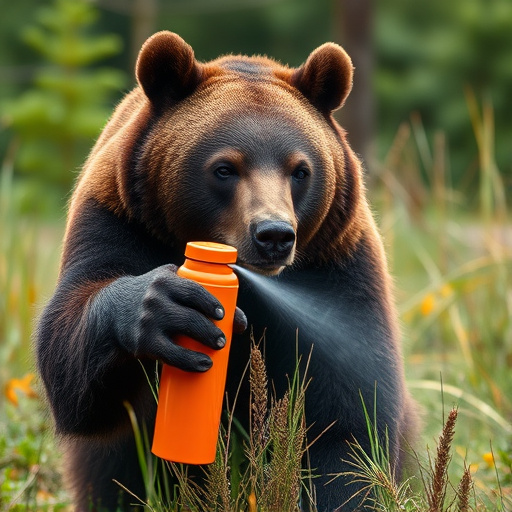Bear spray residue has immediate irritation effects on bears but quickly dissipates. While non-toxic to most wildlife, misuse can contaminate ecosystems. Alaska's diverse wildlife faces risks from overapplication and misperceptions about 30-foot range limits. Advanced tech solutions offer wider protection with reduced environmental impact while enhancing outdoor safety in bear country.
“Alaska’s vast wilderness is home to powerful bears, making understanding bear repellent effectiveness crucial for visitors and residents alike. This article delves into the intricacies of bear spray usage, focusing on key aspects such as residue impact, wildlife safety, and maximum range legends busted.
We explore ‘Bear Spray Residue: What Stays Behind?’ to uncover the lasting effects. Additionally, ‘Wildlife Impact’ section analyzes potential risks for both humans and animals. Go beyond the spray with our guide on ‘Effective Repellents’ for comprehensive protection in Alaska’s bear country.”
- Bear Spray Residue: What Stays Behind?
- Wildlife Impact: Understanding Exposure Risks
- Maximum Range: Fact vs. Myth Debunked
- Effective Repellents: Beyond Just Bear Spray
Bear Spray Residue: What Stays Behind?
Bear spray, a popular and effective deterrent against aggressive bears, leaves behind more than just a pungent scent. When deployed, bear spray creates a residue that can have lasting effects on both the animal and the environment. This residue is composed of various chemicals, including capsaicin, which gives the spray its heat-inducing properties. While it’s an essential tool for self-defense in bear country, understanding the nature of this residue is crucial to assessing its potential impact on wildlife and ecosystems.
The lingering effects of bear spray residue are multifaceted. For bears, direct contact with the eyes or skin can cause severe irritation, pain, and even temporary blindness or disorientation. However, it’s important to note that these impacts are generally short-lived, as the residue is water-soluble and should not accumulate in significant amounts. In contrast, the environmental impact is more nuanced. The residue can persist in water bodies and soil, potentially affecting non-target species and aquatic life. Yet, studies suggest that the levels of capsaicin typically found post-spraying are below toxic thresholds for most wildlife, indicating minimal long-term effects on local ecosystems.
Wildlife Impact: Understanding Exposure Risks
In Alaska, where wildlife encounters are common, understanding the impact of bear repellent maximum ranges and their effects on both humans and animals is crucial. Bear spray residue can travel beyond the stated range, impacting not just the intended user but also surrounding wildlife. The mist from bear spray can remain suspended in the air and settle on vegetation, potentially exposing animals like birds and small mammals to toxic levels. These residues can cause respiratory distress or even death for susceptible species, highlighting the need for responsible usage and awareness of cross-contamination risks.
Moreover, while bear repellent is designed to deter aggressive behavior, improper use or excessive application can lead to negative ecological consequences. For instance, if sprayed near water bodies or in high-traffic wildlife areas, the chemical compounds could contaminate habitats and disrupt the delicate balance of local ecosystems. Thus, it’s essential for users to familiarize themselves with safe handling practices and adhere to recommended usage guidelines to minimize potential harm to Alaska’s diverse wildlife population.
Maximum Range: Fact vs. Myth Debunked
Many people believe that bear repellent spray has a limited range and may not be effective beyond 20 or 30 feet. However, this is largely a myth. The maximum range of bear spray depends on several factors, including the weather conditions, terrain, and the specific product’s formulation. In ideal conditions, some high-quality bear sprays can reach up to 65 feet (around 20 meters).
Understanding the concept of bear spray residue is key. The spray forms a thin layer of chemicals that can linger in the air and settle on surfaces. This residue acts as a deterrent even after the initial mist has dispersed, increasing the effective range. Moreover, the impact on wildlife is minimal when used responsibly. Bear sprays are designed to temporarily disrupt an animal’s behavior without causing significant harm, making them valuable tools for hikers, campers, and outdoor enthusiasts in bear country.
Effective Repellents: Beyond Just Bear Spray
When considering bear repellent for maximum range in Alaska, it’s crucial to look beyond just bear spray. While bear spray is a common and effective deterrent, its effectiveness decreases with distance, and improper use can lead to harmful bear spray residue that impacts wildlife. Beyond bear spray, there are innovative solutions like motion-activated devices and ultrasonic repellents that can offer longer-lasting protection.
These advanced repellents take advantage of technology to create a wider barrier against bears. Motion sensors detect movement and trigger sounds or vibrations that deter bears from approaching, reducing the need for direct application of bear spray. Additionally, ultrasonic repellents emit high-frequency sound waves that are unpleasant to bears but harmless to humans and other wildlife, providing a more environmentally friendly option with a longer range.
Understanding the effectiveness of bear repellents, from bear spray residue and its impact on wildlife to the debunking of maximum range myths, is essential for safe navigation in Alaska’s wild landscapes. While bear spray remains a popular choice, it’s crucial to recognize that its residue can persist and potentially pose risks to animals and ecosystems. By considering alternative repellents and practicing responsible outdoor behavior, visitors can help minimize their impact while enjoying the beauty of Alaska’s wilderness responsibly.
